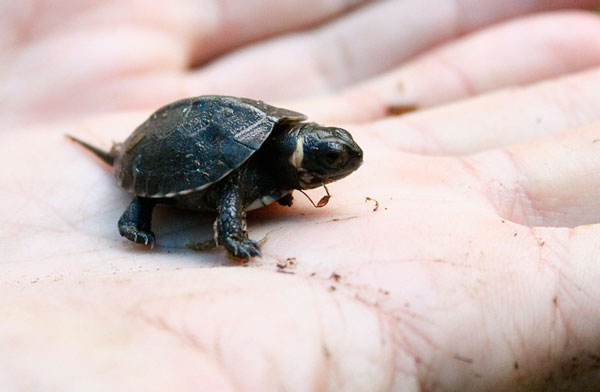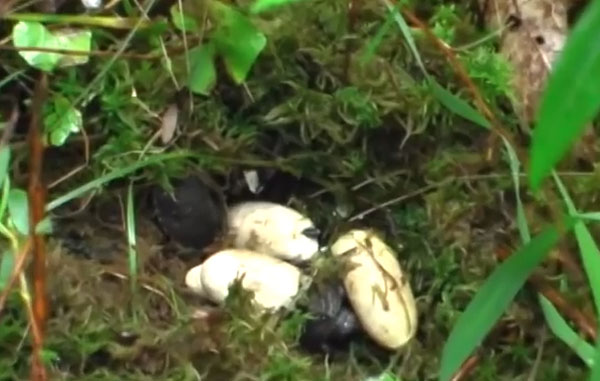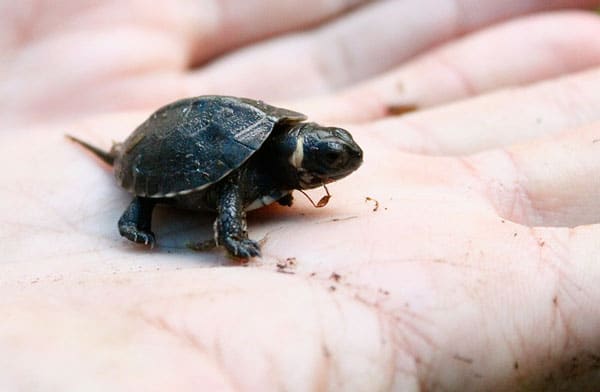The bog turtle (Glyptemys muhlenbergii) is a small and charismatic species. Captive bred animals are easy to care for and easy to breed. This spe
The bog turtle (Glyptemys muhlenbergii) is a small and charismatic species. Captive bred animals are easy to care for and easy to breed. This species is rare, both in the wild and in captivity and efforts need to be made to promote the captive reproduction of this species.
The bog turtle attains sexual maturity only once they have attained a minimum plastron length of 6.5 cm for males and 7.0 cm for females. In the wild, these sizes are attained at 4 to 6 years of age or older. A bog turtle raised in captivity attains sexual maturity at about the same age.
Mature bog turtles need to be hibernated in order to synchronize their reproductive cycles. Hibernation methods vary, but I choose to hibernate my bog turtles separately and in shallow water at 6º C- 8º C for three to four months. The turtles must be fasted and have an empty digestive system before being cooled. This pre-hibernation fasting lasts up to three weeks.

Rosie Walunas/U.S. Fish and Wildlife Service
Newly hatched bog turtles are minuscule measuring 21-29mm (0.8-1.14'') in shell length.
Once awake, the male and female bogs turtles will remain separated. I will place the male and females together, under supervision, and separate them once there is a successful coitus. The male will exhibit aggressive biting and mounting behaviors before attempting intromission.
It's very important that the female receives enough dietary calcium during the egg production stage. I provide calcium by making a piece of cuttlebone available to the female at all times.
The female will two to six eggs about six to eight weeks after emerging from hibernation. The nesting area should be provided several weeks before her expected laying date. A good nesting area consists of damp sphagnum moss, located under the heat lamp, and sheltered by artificial plants.
Once the eggs are laid, they are removed and then placed into damp sphagnum moss.
Note: sphagnum moss is my preferred incubation substrate due to its ability to retain moisture without pulling it from the egg, and also for its natural anti-fungal properties. Sphagnum moss is not the same as forest moss.

USFWS
Bog turtles lay from two to six eggs.
The moss and eggs are contained within a small plastic container ventilated with a few small holes along the sides. The bog turtle exhibits genetic sexual determination, therefore the incubation temperature doesn't affect the gender of the growing embryos. The eggs can be incubated between 25ºC and 28ºC (77F -83F). Incubation time varies between 42-80 days and is influenced by incubation temperatures. There are many styles of incubators available and any can work, as long as the incubation substrate remains moist throughout the entire incubation period.
Newly hatched bog turtles are minuscule measuring 21-29mm (0.8-1.14'') in shell length! A baby may pip out its egg, make a hole just large enough to poke its head out and sit there for several days before emerging completely. The babies must remain in the incubator, and left untouched, until they’re completely out of their eggs, and their yolk sac is absorbed. Only at this time can they be transferred to a prepared baby enclosure.
When a baby bog turtle is observed for the first time, it seems almost impossible to believe that this tiny turtle can survive in the wild. In captivity, newly hatched bog turtles are alert, and active and will thrive when kept under ideal conditions.
Julie Tougas has been obsessed with turtles ever since she received her first red eared slider more than 30 years ago. This passion has lead to the completion of an undergraduate degree studying zoology and to the development of her current collection of turtles. She now work with more than 100 adult turtles and has successfully reproduced more than 20 species. Tougas has been keeping and breeding bog turtles for more than 10 years. Company name: CBC Turtles and Tortoises ( Turtles and Tortoises that are Captive Bred in Canada)
website: captivebredturtles.ca



